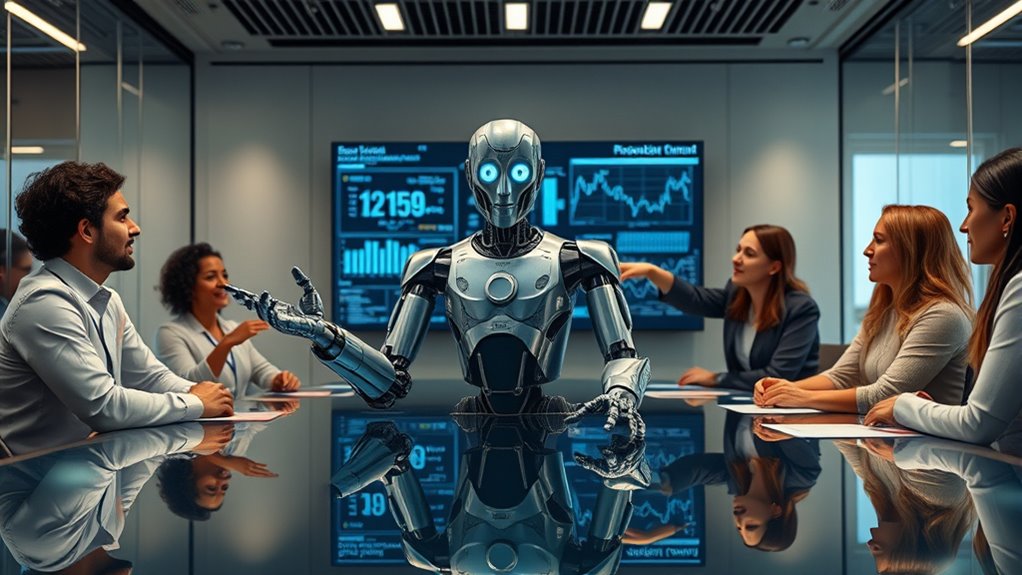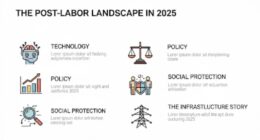As AI tools like ChatGPT become trusted coworkers, you’ll find routine tasks automated, freeing you to focus on strategic work. Teams that embrace AI experience increased productivity, faster decision-making, and better collaboration. AI supports innovation and helps handle complex data in real time. Since many organizations are integrating AI into daily workflows, understanding how to collaborate effectively with your AI coworker is essential—continue exploring to see how this shift can transform your work life.
Key Takeaways
- AI tools like ChatGPT are increasingly integrated into teams to enhance productivity and automate routine tasks.
- Clear communication about AI roles and functions fosters transparency and trust among team members.
- Ensuring fairness and regular bias assessments are vital to prevent discrimination and promote ethical AI deployment.
- AI coworkers support decision-making and collaboration, transforming traditional team dynamics and workflows.
- Responsible AI use involves transparency, accountability, and ongoing audits to build trust and minimize harm.
The Growing Familiarity With AI Tools in the Workplace

By early 2025, nearly everyone in the workplace has become familiar with AI tools, reflecting a rapid and widespread adoption. You likely use generative AI daily, with 94% of employees reporting some familiarity, and nearly all C-suite leaders aware of these tools. Mid-level employees are leading the charge, using AI 3.5 times more often than managers, making them the primary drivers of adoption. About three-quarters of workers were using AI at work by 2024, with many adopting it recently, within the last six months. This shift shows a clear recognition that AI enhances tasks beyond automation, becoming an essential part of everyday work. The rapid familiarity underscores how AI is transforming workplace culture and operational habits across industries.
How AI Is Transforming Daily Tasks and Boosting Productivity

AI automates routine tasks, freeing you to focus on more strategic work. It also speeds up decision-making by providing quick, data-driven insights. As a result, your team becomes more flexible, adapting easily to changing priorities and workload demands. Recent advancements in AI performance have further enhanced these capabilities, making AI tools more reliable and valuable in everyday work scenarios. Additionally, improvements in project management tools help streamline workflow and facilitate better collaboration across teams. These innovations support workforce adaptability, allowing teams to respond swiftly to new challenges and opportunities. Moreover, understanding individual team members’ personality traits can optimize AI integration by tailoring workflows to diverse working styles. Recognizing the importance of mental wellbeing, teams can also foster a healthier work environment that promotes overall productivity and satisfaction.
Streamlining Routine Tasks
As organizations increasingly adopt automation tools, routine tasks across various industries are being transformed to boost productivity. With 70% planning to implement structured automation by 2025, you’re likely to see your daily workload become more manageable. AI can automate at least 30% of tasks in many roles, reducing monotony and freeing up your time for higher-value work. IT workers report increased satisfaction as automation handles repetitive duties, and many companies prioritize self-service features to streamline processes further. In manufacturing and customer service, AI accelerates workflows and improves efficiency. This shift not only enhances productivity but also boosts employee satisfaction, as routine tasks become less burdensome. Overall, AI is reshaping how you approach daily responsibilities, making work more efficient and engaging. A significant 60% of companies currently utilize automation tools in workflows and continue to expand their automation capabilities.
Enhancing Decision-Making Speed
When it comes to making decisions quickly and accurately, AI plays a crucial role by analyzing vast amounts of data in real time. This enables you to gain rapid, precise insights that drive smarter choices. AI-powered tools replace traditional data analysis with real-time analytics and predictive capabilities, helping you anticipate trends before they happen. As a result, decision-making becomes faster and more reliable. Traditional data analytics methods are limited in providing immediate insights, which emphasizes the importance of AI’s ability to process data instantaneously. Here are three ways AI enhances your decision speed: 1. It handles complex data sets instantly, uncovering hidden patterns. 2. It automates analysis, freeing you from manual work. 3. It provides real-time insights, allowing quick responses to changing conditions. Additionally, the integration of on-device AI capabilities like Snapdragon 8 Gen 3 supports faster processing directly on mobile devices, further streamlining decision-making processes.
Increasing Workforce Flexibility
The integration of AI into daily workflows is transforming how you adapt to changing environments and take on tasks with greater flexibility. You’re increasingly comfortable working alongside AI, with 71% willing to be flexible as conditions shift. Flexible work arrangements, favored by 68.7%, help improve your work-life balance and support professional growth. To stay relevant, employers are providing AI skills training, enabling you to develop new competencies and advance your career. AI-driven platforms streamline job matching, making it easier to find roles aligned with your skills and preferences. This increased flexibility allows you to handle diverse tasks more efficiently, boosting productivity. Additionally, the majority of workers are eager to learn new AI skills, recognizing that personal finance management can be cultivated by anyone, regardless of skill level, and this proactive approach is vital for maintaining a competitive edge. Developing digital literacy is essential as AI technologies become more integrated into various aspects of work. As AI continues to evolve, your ability to adapt will be key to thriving in this dynamic, future-ready workforce. Embracing AI ethics jobs can also position you as a responsible innovator in technology. Moreover, understanding Mazda tuning principles can inspire innovative thinking and technical skills that are applicable across industries.
The Expanding Role of Generative AI Across Business Functions

Generative AI is rapidly transforming various business functions, from enhancing creative tasks to improving data analysis. It automates routine processes, freeing up your team to focus on strategic initiatives. As it expands across departments, you’ll find new opportunities to boost efficiency and innovation. Additionally, AI can assist in optimizing home furnishings by providing personalized product recommendations and improving customer service experiences.
AI in Creative Tasks
AI is transforming creative tasks across industries by enabling faster and more diverse content production. You can now generate marketing copy, blog posts, and social media content in minutes, not hours. Visual assets like logos, illustrations, and videos are created automatically, boosting creative output with minimal effort. Natural language generation helps craft scripts and storytelling for multimedia projects at scale. Here are three key impacts:
- Faster content creation accelerates project timelines and reduces costs.
- Diverse AI-generated assets foster innovation and broaden creative options.
- Automated ideation sparks new ideas, pushing your team toward higher-level strategic work.
Additionally, AI’s ability to mimic human creativity raises important questions about authenticity and originality in content creation, especially as it intersects with creative industries and intellectual property concerns.
Data Analysis Enhancements
Advancements in generative AI are revolutionizing data analysis by enabling faster, more insightful discoveries across various business functions. You can now sift through massive datasets automatically, uncovering actionable insights with ease. AI-generated analysis simplifies understanding complex data and enhances comparison across multiple variables. Large language models help you generate targeted questions and relevant queries, refining your data exploration process. This democratizes analytics, allowing non-technical professionals to draw valuable conclusions without deep data science expertise. Enterprises are evolving data platforms—adopting vector databases and improving data pipelines—to support multimodal AI applications. Prompt engineering and embedding libraries optimize outputs and similarity searches. Additionally, integrating vetted data analysis tools ensures accuracy and compliance in your insights. Implementing scalable data infrastructure enables organizations to handle increasing data volumes efficiently. By integrating these tools, you gain real-time insights that accelerate decision-making, reduce costs, and foster a more data-driven culture across your organization.
Automating Routine Processes
As organizations increasingly adopt automation, generative AI plays a pivotal role in streamlining routine processes across business functions. Its adoption doubled to 65% in 2023-2024, delivering an impressive return of $3.70 for every dollar invested. This rapid growth spans sectors, with usage rising from 33% to 71%, and companies see cost reductions and productivity gains. To maximize AI’s benefits, focus on:
- Leveraging AI for repetitive tasks to free up talent for strategic work.
- Overcoming talent gaps by investing in AI skills and training.
- Addressing security concerns to build customer trust and ensure smooth integration.
These steps help you harness AI’s full potential, improving efficiency and competitive edge while mitigating risks associated with adoption.
Overcoming Barriers to Seamless AI Integration

Overcoming barriers to seamless AI integration requires addressing both technical and human-centric challenges. You’ll face integration issues, especially with legacy systems, and need to prioritize data readiness to *unbolt* AI’s full potential. Technological complexity can slow progress, so starting small with manageable projects helps build confidence. Additionally, understanding AI Developments can help organizations stay ahead of technological advances and adapt their strategies accordingly. Recognizing human factors such as workforce development and cultural attitudes toward AI is crucial for smooth adoption. Building employee trust involves addressing concerns about accuracy and security, supported by effective change management and ongoing training. Strong data governance, high-quality data, and compliance with regulations are essential for smooth AI adoption. Furthermore, aligning AI initiatives with mindfulness practices can promote a more thoughtful and ethical implementation process, fostering a culture of responsible innovation. Additionally, implementing security measures such as continuous threat monitoring and regular updates can significantly mitigate risks. Emphasizing ethical considerations in AI deployment ensures fairness and transparency, which are vital for long-term success. Ultimately, a strategic, well-planned approach that combines technical solutions with engaging your team creates the foundation for successful AI integration.
The Future of Work: Embracing AI for Innovation and Efficiency

Embracing AI in the workplace is transforming how we work, driving innovation and boosting efficiency across industries. You’ll find AI now deeply integrated into daily workflows, enabling faster data analysis, smarter decision-making, and automation of routine tasks. This shift allows you to focus on higher-value, creative, and strategic activities. Here are three key insights:
- AI enhances productivity, with 77% of managers adopting tools to improve efficiency and collaboration.
- It accelerates innovation through real-time insights, enabling rapid experimentation and problem-solving.
- Workforce transformation is underway, with over 20 million workers retraining to develop AI-related skills, emphasizing the importance of advanced segmentation techniques.
- Proper use of paint sprayers can significantly improve project efficiency and quality, demonstrating how adopting new tools supports workplace evolution. Incorporating proper maintenance practices ensures longevity and optimal performance of equipment, further supporting operational efficiency.
This evolution positions AI as a crucial partner in shaping a more dynamic, innovative future of work.
Strategies for Effective AI Adoption and Employee Engagement

Implementing AI effectively in the workplace requires more than just deploying new tools; it demands strategic efforts to build AI literacy and foster employee engagement. You should focus on increasing AI familiarity across all levels—since 94% of employees and 99% of leaders already have some knowledge—but also work to improve comfort levels. Providing extensive training programs helps bridge gaps between AI-savvy and less engaged employees, encouraging a more inclusive environment. Recognizing that engaged employees are more open to AI, which boosts productivity and innovation, is essential. Address resistance by communicating AI’s benefits clearly and creating career pathways aligned with AI skills. By promoting collaboration and addressing fears about job security, you can cultivate an environment where AI adoption enhances both employee satisfaction and organizational competitiveness. Incorporating predictive modeling into workplace strategies can further personalize employee development and optimize organizational outcomes, especially when combined with a comprehensive understanding of agent programs & merchant services and their potential impact on operational efficiencies. Additionally, fostering a culture of continuous learning around AI ensures long-term adaptation and success. Understanding how Honda Tuning can enhance vehicle performance demonstrates the importance of expertise and ongoing learning in specialized fields, similar to fostering continuous AI education in the workplace.
Navigating Ethical Challenges and Preparing for Workforce Changes

As organizations integrate AI into their workflows, they must address significant ethical challenges to guarantee responsible use. You need to be aware of issues like job displacement, data privacy, bias, and transparency. To navigate these, consider these key steps:
- Upskill Employees: Equip your team with new skills to adapt to AI-driven roles and reduce displacement concerns.
- Implement Bias Mitigation: Use diverse, high-quality data and bias detection tools to promote fairness.
- Build Trust Through Transparency: Clearly communicate AI deployment, decision-making processes, and accountability measures.
Frequently Asked Questions
How Do Organizations Measure Ai’S Impact on Employee Productivity?
You track AI’s impact on productivity by analyzing real-time dashboards that reveal performance changes across teams and individuals. Use time-tracking tools, productivity metrics like output hours, and quality assessments before and after AI integration. Compare data on task completion speed, resolution rates, and overall efficiency. Automated systems like Prodoscore help minimize manual logging, giving you clear insights into how AI boosts throughput, quality, and job satisfaction over time.
What Skills Are Essential for Workers to Effectively Collaborate With AI Tools?
To collaborate effectively with AI tools, you need a mix of skills. You should understand how generative AI works and be able to craft clear prompts. Being data literate helps you interpret AI outputs, while technical proficiency ensures smooth integration. Additionally, adaptability is key—you must stay open to learning new tools. Strong communication and emotional intelligence also help you work alongside AI, ensuring seamless teamwork and making the most of AI’s capabilities.
How Can Companies Ensure Ethical Use of AI in Decision-Making Processes?
To guarantee ethical AI use in decision-making, you should establish clear governance structures, like ethics review committees and risk management frameworks. Conduct regular training for employees and leadership to promote responsible AI practices. Implement ongoing ethical audits and impact assessments to catch issues early. Balance innovation with oversight by setting policies that define ethical boundaries while allowing for responsible experimentation. Stay adaptable by continuously updating your frameworks as technology evolves.
What Are Best Practices for Training Employees on New AI Technologies?
When training employees on new AI technologies, you should focus on personalized learning that fits different skill levels and learning styles. Use engaging, hands-on methods like digital simulations and AI-powered tools to boost understanding and retention. Keep training ongoing to adapt to rapid AI advancements, and address skill gaps proactively. Encourage questions and feedback to foster confidence, ensuring your team stays competent and comfortable with the evolving AI landscape.
How Will AI Influence Job Roles and Workforce Dynamics in the Next Decade?
AI will reshape your job roles and workforce dynamics by automating routine tasks, augmenting complex problem-solving, and creating new opportunities. You’ll need to cultivate AI literacy, adapt to hybrid skillsets, and embrace continuous learning. As collaboration with AI becomes more seamless, your workplace will become more flexible and innovative. Staying proactive, ethical, and adaptable guarantees you thrive amid these changes and leverage AI’s full potential in your career.
Conclusion
As you integrate AI like ChatGPT into your team, remember that 70% of workers report increased productivity with AI tools. Embracing this change can boost innovation and efficiency, but it also requires steering ethical concerns and workforce adjustments. By staying adaptable and engaged, you’ll not only stay ahead but also create a work environment where AI becomes your trusted coworker, empowering you to achieve more with less effort.









